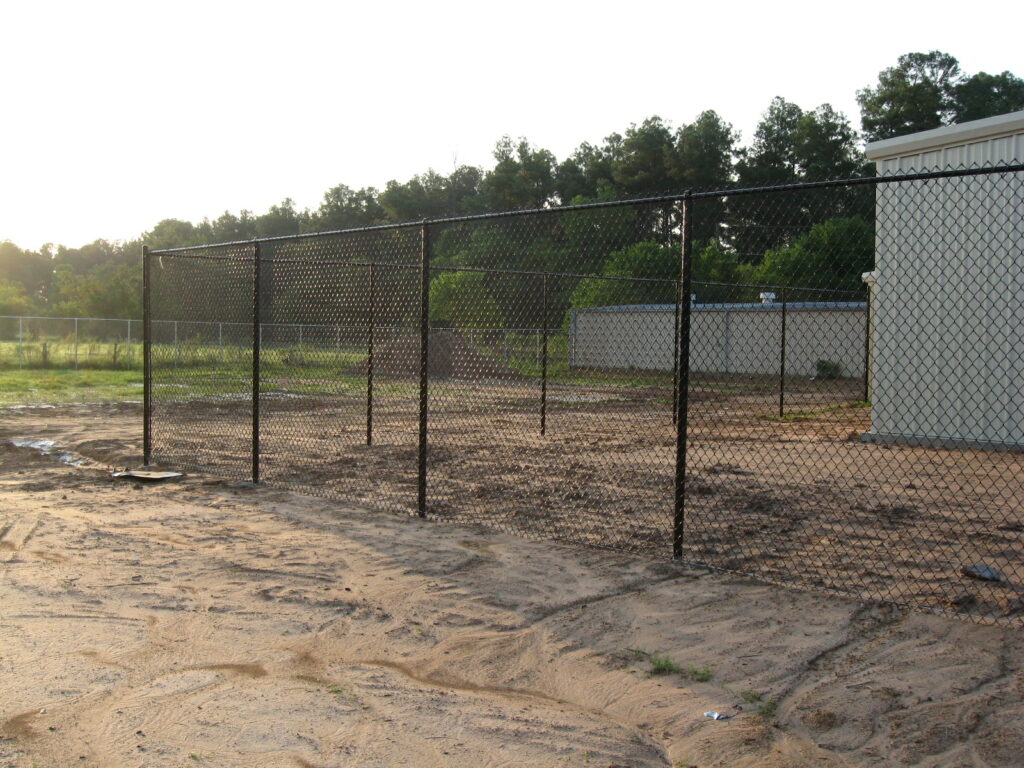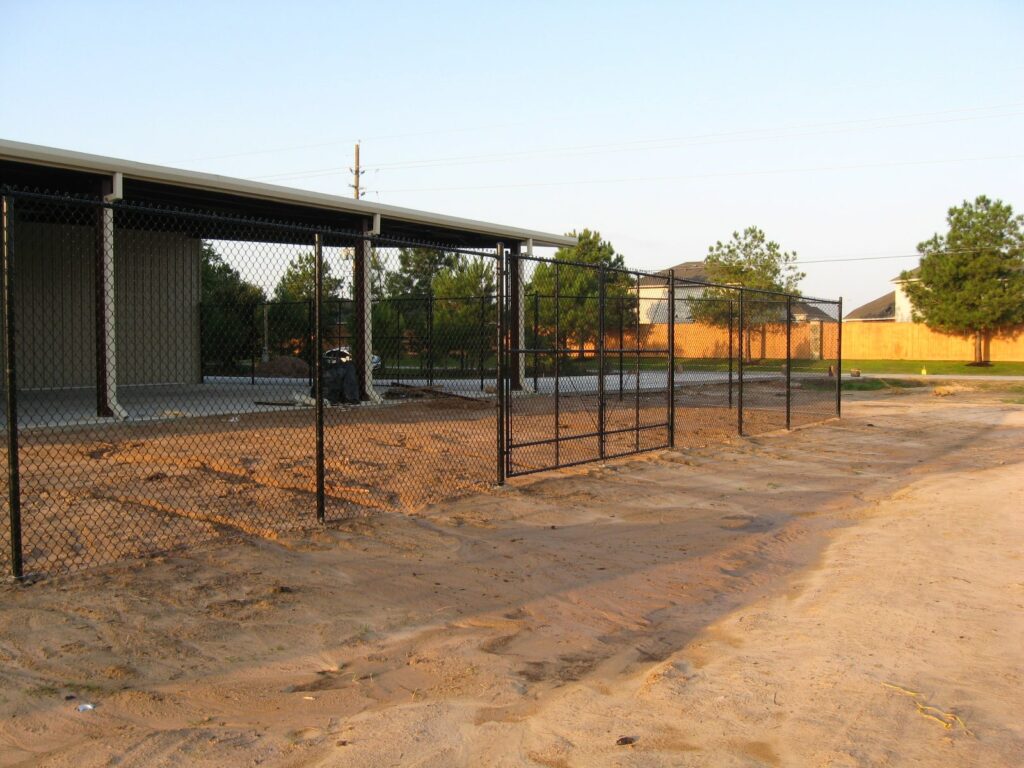A chain link fence is a type of fencing that consists of a series of metal posts and wire strands that are connected together to form a mesh. The posts can be made from either steel or aluminum, and the wire strands are typically made from galvanized steel. Chain link fences are commonly used to delineate property boundaries, as well as to provide security and safety in both commercial and residential settings.
One of the main advantages of a chain link fence is that it is relatively inexpensive compared to other types of fencing. Additionally, chain link fences are easy to install and require little maintenance. However, one downside of chain link fences is that they are not as visually appealing as other types of fencing, such as wood or vinyl.
If you are considering installing a chain link fence, it is important to familiarize yourself with the different parts of the fence. The posts are the vertical supports that hold up the wire mesh, and can be either steel or aluminum. The wire strands are what actually create the mesh, and are typically made of galvanized steel. The tension bands are what keep the wire strands tight, and are usually made of either steel or aluminum. Finally, the post caps are what go on top of the posts to give them a finished look.
Now that you know the basics of what a chain link fence is, you can decide if it is the right fence for you. Chain link fences are a popular choice because they are affordable, durable, and easy to maintain. They are also one of the most versatile types of fences, as they can be used for both residential and commercial applications. If you need a fence that will provide security and privacy, a chain link fence is a great option.

How Much Does A Chain Link Fence Cost?
Chain link fence prices vary depending on the materials used, the height of the fence, and the length of the fencing. For example, a chain link fence that is made from aluminum and is 6 feet tall will cost more than a chain link fence that is made from steel and is 4 feet tall. The price also depends on whether you choose to install the fence yourself or hire a professional to do it for you.
How To Calculate Chain Link Fence Cost
Chain link fence cost calculation is determined by its length and height. The chain link fence cost will also be affected by the type of chain link fencing you choose. The three most popular types of chain link fencing are galvanized, aluminized and vinyl coated. The cheapest type of chain link fencing is galvanized, while the most expensive is vinyl coated. To calculate chain link fence cost, first determine the length and height of the fencing you need. Next, decide on the type of chain link fencing you want. Finally, determine the price per linear foot for the fencing you want and multiply that number by the total length of fence you need. The chain link fence cost will vary depending on these factors, but you can get an estimate of what it will cost to install a chain link fence by using this simple calculation.
Factors In Calculating The Cost Of A Chain Link Fence
Chain link fence cost can vary based on a number of factors. The most important factor is the size of the fence. Chain link fences come in a variety of sizes, from small residential fences to large commercial ones. The type of chain link fence you choose will also affect the price. chain link fence are made from a variety of materials, including aluminum, steel, and vinyl. The type of material you choose will determine the price of your fence.
Another important factor to consider when budgeting for a chain link fence is the installation cost. If you hire a professional contractor to install your fence, expect to pay between $15 and $30 per linear foot. If you decide to install the fence yourself, you can save money on labor costs. However, it is important to note that chain link fence installation is not a DIY project. If you are not experienced in fence installation, it is best to hire a professional.
The installation location of your chain link fence will also affect the cost. If you need to have your chain link fence installed on a slope, the cost will be higher than if it was installed on level ground. The type of soil in your yard can also affect the cost of installation.

Do You Really Need A Chain Link Fence?
A chain link fence is one of the most popular types of fencing because it is affordable, durable, and easy to install. There are many benefits to installing a chain link fence:
- It can provide safety for your family and pets. It can keep them from wandering off into areas where they could be hurt or get lost.
- It provides security for your home or business. It can deter burglars and other intruders from entering your property.
- A chain link fence is also low maintenance. Once it is installed, you won’t have to worry about painting or staining it.
- It’s an environmentally friendly fencing option. It is made from recycled materials and it is 100% recyclable.
- Lastly, a chain link fence can add value to your home or business. It can make your property look more attractive and increase its curb appeal.
How To Save Money On Chain Link Fence Costs
If you’re looking for a fencing option that is both affordable and effective, then a chain link fence is a great choice. Here are some tips on how you can save money on chain link fence costs:
1. Shop around. Get quotes from different companies before you choose a supplier.
2. Buy in bulk. If you need a lot of chain link fence, buying in bulk can help you save money.3.
3. Choose a less expensive material. Galvanized steel is a good option if you’re looking to save money.
4. Hire a professional installer. This can save you time and money in the long run.5.
5. Ask for discounts. Many suppliers offer discounts for bulk orders or for customers who pay in cash.
By following these tips, you can save money on chain link fence costs and get the fencing solution that you need.

How To Install A Chain-link Fence DIY
- Decide where you want to install your fence.
When it comes to installing a fence, one of the most important decisions you’ll make is where to place it. There are a few factors to consider when making this decision. First, you’ll need to decide which side of your property the fence will be on. If you’re planning on using the fence to create additional privacy, then you’ll want to choose a side that faces away from your neighbor’s property. You’ll also need to take into account the layout of your land. If your property is sloped, you’ll want to make sure that the fence is installed on level ground. Otherwise, one side of the fence may be higher than the other, which can create an uneven appearance. Finally, you’ll need to make sure that there are no underground utilities running through the area where you plan to install the fence. Once you’ve taken all of these factors into consideration, you’ll be ready to choose the perfect spot for your new fence. - Call 811 to have utility lines marked before you dig any holes.
Fence installation can be a tricky process, especially when it comes to utility lines. Before you start digging fence holes, it’s important to call 811 to have your utility lines marked. This way, you can avoid damaging any underground lines and incurring costly repairs. The process is simple: just call 811 a few days before you start digging, and a technician will come out to mark the location of your utility lines. Once the lines have been marked, you can proceed with fence installation without worry. So don’t forget – when it comes to fence holes, always call 811 first! - Choose the type of posts you want to use for your fence. Metal posts are more durable than wood, but they cost more upfront.
Fence posts are an essential part of any fence, providing both support and stability. But with so many different types of fence posts on the market, how do you know which one is right for your fence? Here are a few things to consider when choosing fence posts:
– The material the post is made from. Wooden fence posts are the most popular choice, but metal fence posts are also an option.
– The size of the post. Make sure to choose a fence post that is big enough to support the weight of your fence.
– The design of the post. Decorative fence posts can add a touch of style to your fence, while more functional fence posts will be less noticeable.
With so many different types of fence posts available, there is sure to be one that is perfect for your fence. By taking the time to choose the right fence post, you can ensure that your fence will be strong and stable for years to come. - Install end, corner, and gate posts first. These posts will be sturdier if they’re buried at least 2 feet deep in the ground.
When installing a fence, it is important to start with the end, corner, and gate posts. These posts will be sturdier if they are buried at least 2 feet deep in the ground. This will help to prevent the posts from tipping over or being pulled out of the ground by wind or animals. In addition, it is important to use high-quality materials for the posts. Pressure-treated lumber or metal posts are both good options. Finally, be sure to check local building codes before installation to ensure that you are following all of the required guidelines. - Put tension bars through the holes in the end posts and screw them in place.
This will help keep your fence tight and looking great. tension bars are an essential part of any fence, so don’t forget to include them! - Place tension bands on the corner and gate posts and screw them into place.
One way to help prevent soil erosion is to use tension bars. Tension bars are placed on the corner and gate fence posts and screwed into place. The tension bar helps to hold the soil in place and prevents the post from moving. The tension bar is also helpful in preventing the soil from eroding around the post. The tension bar is placed on the post before the post is installed. The tension bar is then screwed into place after the post is installed. The tension bar is available in different sizes and lengths. The tension bar is also available in different finishes, such as zinc-plated or galvanized. - Unroll the chain-link fabric and stretch it out along the fence line.
This can be a difficult task if you’re working alone, so it’s important to have a helper on hand to hold one end of the chain link while you stretch it out. Once you have the chain link stretched out, you can then begin attaching it to the posts. Be sure to use gloves when handling the chain link, as the sharp edges can easily cut skin. - Clip the fabric to the tension bands on the posts.
This will ensure that the fabric is secure and will not move when you are installing the fence. It is also important to make sure that the clip is facing the right way so that it can be easily removed when you need to take the fence down. If you are not sure how to clip the fabric to the tension bands, you can always ask a professional for help. - Use a come-along to tighten the chain-link fabric.
When installing a chain-link fence, it is important to make sure that the fabric is tight. Otherwise, the fence will sag and may not be able to provide the level of security that you need. One way to tighten the fabric is to use a come-along. This is a tool that consists of a ratchet and a cable. To use it, simply attach the cable to the post and ratchet the handle until the fabric is tight. Come-alongs are available at most hardware stores and can be an essential part of any fencing project. - Zip-tie the fabric to the top rail of the fence.
Zip-ties are an easy and effective way to attach chain link fabric to the top rail of a fence. First, thread the zip-tie through the fabric and around the top rail. Next, pull the zip-tie tight and snip off the excess. Finally, use a pair of pliers to crimp the end of the zip-tie, securing it in place. Repeat this process every few inches until the entire length of fabric is secured. By using zip-ties, you can quickly and easily install chain link fabric without having to weave it through the fence mesh. This method is also much less likely to damage the fabric than weaving it through by hand. - Add post caps to the posts.
Post caps are an important part of any fence. They help to protect the posts from weather damage, and they also add a decorative touch. There are many different styles of post caps available, so you can choose the ones that best suit your taste. Some post caps are made from wood, while others are made from metal or plastic. You can also find post caps with different designs, such as those with solar lights or those with built-in drainage holes. When choosing post caps, be sure to select the ones that are sized correctly for your posts. In addition, you’ll need to decide whether you want the caps to be installed before or after the posts are installed. If you’re not sure which option is best for you, consult with a professional fencing contractor. - Install ground staples every 10 feet or so along the bottom of the fence to keep the fabric in place.
To keep your fabric in place, you’ll need to install ground staples every 10 feet or so along the bottom of the fence. To do this, first mark out the locations for the staples using a measuring tape and a piece of chalk. Then, use a hammer to drive the staples into the ground. Be sure to angle the staple so that it’s pointing inwards, towards the fence. This will help to hold the fabric in place and prevent it from being blown away by the wind. Finally, give the fence a quick once-over to make sure that all of the staples are securely in place. With a little bit of effort, you can keep your fabric in place and enjoy a beautiful, well-protected garden all season long. - Hang gates, if desired. Make sure they’re properly balanced so they don’t sag over time.
The best way to balance a gate is to hang it from heavy-duty hinges that are mounted securely to the posts. Additionally, use adjustable screws or turnbuckles to fine-tune the tension on the hinges. By following these simple tips, you can ensure that your fence gates will function properly for years to come. - Put a latch on each gate so it can be opened and closed easily.
By doing this, you will be able to keep animals and young children from getting out of the yard and into the street. It is also important to make sure that the latch is not too high for small children or animals to reach. You may need to adjust the height of the latch as your child grows. If you have a pet, you will also need to make sure that the pet cannot reach the latch and open the gate. - Trim any excess fabric from the posts.
First, use a tape measure to determine how much fabric needs to be removed. Next, use a pair of pliers to grip the fabric and cut it to the desired length. Finally, use a file or sandpaper to smooth any rough edges. By taking a few minutes to trim the fabric, you can ensure that your fence looks neat and professional. - Add privacy slats if desired.
Privacy slats are available in a variety of materials, including wood, vinyl, and aluminum. Most privacy slats are easy to install and can be added to any type of fence. When choosing privacy slats, it is important to consider the height of your fence, the width of the slats, and the spacing between the slats. You will also want to take into account the climate in your area and choose a material that will stand up to the elements. With so many options available, there is sure to be a fence privacy slat that meets your needs.

Enjoy Your New Fence
Now that you have your new fence, it’s time to enjoy it! Make sure to keep up with regular maintenance so that your fence lasts for years. Thanks for reading our blog post on chain link fences – we hope you found it helpful.







